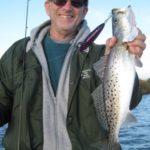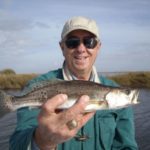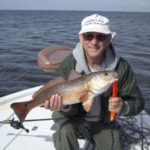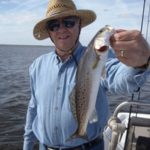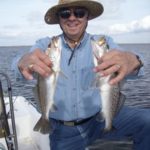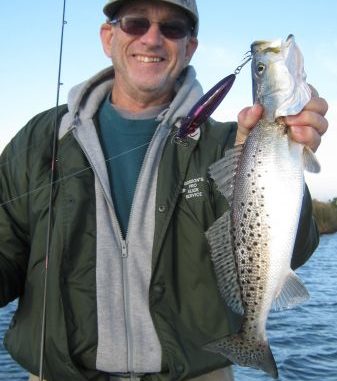
Trout and redfish action in the Sulphur Mine at this Pointe aux Chenes hotspot is hard to beat this month, no matter what the weather does.
February can be a tough month for coastal anglers. Frequent fronts, blustery winds and low water conditions can definitely be a challenge, even to the most experienced among us — and the wet, bone-chilling cold doesn’t exactly invite us to go outside and play on the water.
But anglers with salt water in their veins can only endure the inside for so long before cabin fever sets in and you’ve just got to go fix that ache in your gut for a stretched line and a bent rod.
A February fix might seem unlikely unless you know where to go. Fortunately, at least for those of us in the southeastern part of the state, a fix is not that hard to find.
Find an area that has some deeper water — preferably with an oyster bottom — and some cleaner water and some tidal movement, add any sign of bait in the water and throw in some nearby shallow flats or oyster reefs and you’re likely to have found a winning combination.
The only additional bonus I could add to recommend a spot is birds — specifically seagulls — diving and hovering over any particular area. Sometimes even seagulls just sitting on the water indicates bait beneath them; and, as any experienced angler knows, where there’s bait that’s where the fish will likely be.
So, on one of those recent cold, bleak wintery mornings, an hour before daylight, I met good friend and former guide Gordon Matherne at his house near Bayou Gauche. We picked up his cousin, Ray Matherne, and trailered Gordon’s 22-foot Blazer Bay down Highway 90 to the Highway 1/308 exit near Raceland, and hooked a left on Highway 308 toward Grand Isle.
From the turnoff there, it’s about 15 miles of two-lane highway to Larose — and now that the new bridge over Bayou Lafourche is open in Larose you can cross over and go straight to the four-lane highway and turn left toward Galliano, Leeville, Fourchon and Grand Isle. Every one of these is an excellent fishing destination.
Our destination was Galliano, where we’d launch at Basson’s, and be all of a five- to 10-minute boat ride to the Sulphur Mine.
When you arrive at daybreak at a launch on a cold weekday morning and boats are already launching, well, you know folks are catching fish.
A $5 launch fee gets you access to a back-down and a parking spot, so if you plan to launch here you’ll need to bring your own bait and stuff.
But once launched, it’s a straight run to the Sulphur Mine and its surrounding marsh area.
On these cold mornings, most boats head straight to the mine and park around the deeper hole in the middle, or they choose one of the several passes that flow in and out of the mine on virtually every side.
Gordon Matherne said the middle of the mine now averages about 10 feet deep, plenty deep enough to attract fish on the colder days but a far cry from the 25-foot depths it held just a few years ago.
“Basically, the mine just silted in,” Matherne said. “Hurricane Katrina gets most of the blame, but there have been several storms since then that did the same thing just on a smaller scale.”
What he meant is that Katrina eroded the surrounding marsh and pushed all the mud and silt into the deeper waters of the mine, making it shallower. An that process continued with every storm.
“But it’s still deep enough to be a cold-weather attraction to specks and reds, and when the fish are in there word spreads quick, and you’ll have to wait in line to launch,” Matherne said. “Boats will be parked all over the deep middle and all around the edges at the passes, even on weekdays.”
But he said it’s not necessary to jostle for position at the deep hole.
“Personally, I prefer fishing the passes on the cold days or even heading up into the passes and fishing the passes themselves or the shallower flats and lagoons around them,” Matherne said. “Most of the passes hold 4 to 5 feet of water, and can be productive for both specks and reds.”
Accordingly, Matherne ran across the Sulphur Mine, ignoring the deeper middle section and pointing out several boats anchored, some in the mine just out from the passes and some closer to shore.
“Where you choose to fish will be determined by several factors: current movement, water clarity, temperature and depth being the main things,” he said. “And of course, the weather.”
Matherne motored slowly toward a point jutting into the pass, killed the outboard and dropped the trolling motor over the bow for a stealthier approach.
The depth finder read 3 feet and got shallower as we got closer to the bank, and everyone started casting. Matherne had a blue moon Deadly Dudley on a ¼-ounce jig about 2 feet under a cork while his cousin Ray had on a pair of sparkle beetles he was tight-lining. I had a Vudu shrimp in glow/pink about 2 feet under a cork, and we fanned our casts all around the boat.
The first bump came from Matherne’s cast into the deeper channel, and he said he could tell by the tug it was a small trout. Sure enough, he had an 11-inch speck, and for the next 20 minutes we got bite after bite of mostly undersized fish.
But just enough keepers came across the gunwale to keep us there.
“In general, any of the canals in and out of the mine are good spots to try,” Matherne said. “I like to look for a good current line flowing around any of the points or corners, especially on a falling tide.
“Any sign of a current flow, a foam formation or line, or where clearer water meets dirtier water — those are the places I like to fish.”
We were anchored in just such a place and we were steadily catching fish. All of our baits were producing, but it was quickly apparent that the better bite was coming from under a cork.
On milder days, Matherne said he likes to work a topwater bait along the shallower shoreline of the mine and in the shallow marsh ponds around the mine. The best topwater action comes early in the morning on milder days, when water temperatures are at least in the mid-50-degree range, and it’s especially good after two or three mild days in a row.
“I generally try to fish the falling tides in and around the canals that drain into the mine, starting about a long cast from the corner at the mouth,” Matherne said. “Or I’ll go up into the canals until I get to a break where the marsh is draining into the canal that drains into the mine. Those are my targets on a falling tide.
“On a rising tide, that’s when you want to fish more in the middle of the mine itself, out from one of the mouths of the canals. Use your depth finder and fish in water 6 feet or deeper, and this is where you want to drift and fish soft plastics, bounced slow off the bottom.”
Guide T-Man Cheramie also does a lot of fishing this month in the Sulphur Mine, and he has his own approach and technique.
“I like the northwest side of the mine,” Cheramie said. “That section has some good oyster bottom in 3 to 4 feet of water, where we catch trout, reds, drum and sheepshead.
“The drum haven’t been as plentiful this year as they’ve been in the past, but on everything else the action has been pretty steady.”
Cheramie said to start fishing about 50 yards out from the bank and work your way to within casting distance of the shoreline.
“Troll or drift,” he said. “I toss a chartreuse cocahoe on a ¼-ounce jig as my ‘locater.’ If there’s any fish out there, they’ll hit that chartreuse plastic.
“Then you can stick your Power-Pole or Cajun anchor and try to put some numbers in the boat.”
Similarly to Matherne, he said patience is the key to getting bites.
“Remember this is winter fishing, so make slow retrieves if you’re fishing plastics,” Cheramie said. “I let my bait drag slowly along the bottom, and they’ll tag it if they’re down there.”
Cheramie also likes to take along some live minnows, saying the specks will gobble them up like candy — as will the redfish.
“Hang a minnow on a hook under a cork at one of the points or corners in that northwest side of the mine and if the specks don’t get it the reds will,” he said. “Or put a minnow on a plain jighead and fish it on the bottom at a point or cut or drain, and the reds will suck it in like a vacuum cleaner.”
Cheramie also has a February fishing motto that he swears by. “It’s my three-day rule,” he said. “If we get three days of mild weather — that is, temperatures in the high 60s and above — then I’ll drift and fish that same northwest corner under a cork, and I’ll break out my Bomber Long A’s and Excalibers, and cast and retrieve for some bigger trout.
“That section of the mine holds a lot of trout, and all you need is a few days of warmer weather and those trout will really turn on.
“And if we get three days of cold weather, say, in the 30s, then use your depth finder and fish the deeper holes in the mine or move into the deeper canals. The mine has some areas 10 to 12 feet deep that hold fish, and the deep holes in the canals and bayous are fish magnets in cold water conditions; just toss your plastic, let it sink to the bottom and drag it real slow on the bottom back towards you.”
His approach changes as February ends.
“As soon as March arrives I’ll be tossing topwater baits in the ponds all around the mine and over toward Bully Camp Lake,” Cheramie said.
While we fished we noticed a lot of boats running around from one spot to another like nervous Nellies, unable to sit still for very long. But Matherne said you can’t approach winter fishing with the same aggressiveness as with summer fishing.
In the summer we give a spot a few casts, and if we get no results we move. Or, if we mostly catch undersized trout, we pick up and move.
In the winter you have to be a bit more patient. You fish slower and deeper, and if you’re catching some fish — even if most are undersized — you should think twice before moving. Sometimes adding fish to the box with some steadiness, even if you’re culling through throwbacks, frequently pays off better than running all over and catching little or nothing.
Meanwhile, our trout bite dwindled, and Matherne made a move to one of the other nearby canals that drains the marsh, and we started picking up some better-sized fish.
All of our baits caught fish, but the glow or chartreuse colors got the most hits, and the Vudu shrimp fished under corks was particularly effective.
Matherne likes to smash the barbs of his bait because of the “quick release” provided: As soon as his fish hits the floor of the boat it comes off the hook, and Matherne said the tactic rarely costs him a fish, which proved true on this outing. He even caught a few on a barbless topwater bait after the weather warmed up a bit.
We moved a couple more times, following the same routine. On each move we added a few more trout to the box, and we went home with a bunch of specks and a solitary redfish that fell victim to a Matrix Shad fished tight-lined near a marshy point.
This Sulphur Mine area is easy to access, and it consistently yields some great winter-time trout. What more could somebody needing a February Fishing Fix ask for?
